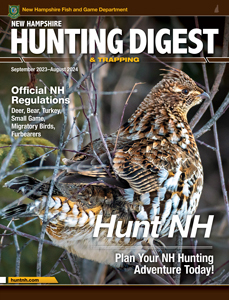Where Can I Hunt in New Hampshire?
In general, the best place to start looking for a hunting spot is a good map—like the New Hampshire Atlas and Gazetteer from Delorme or a “topo” map. To find out who owns a piece of land that’s not labeled as a public park or forest, check the tax maps at the town office.
There are three general categories of land ownership in the state, all of which allow hunting with a few exceptions:
- State and Federal Lands: The White Mountain National Forest is the largest piece of public land in the state (751,000 acres). Hunting is permitted throughout the Forest; however, discharging a firearm is prohibited within 150 yards of a campsite, developed recreation site, occupied area, or on or across a Forest Service road or trail. The Forest has roads open to motor vehicles and gated roads open to foot travel only; if you’re willing to hike a longer distance, this gives you a rare opportunity to hunt locations without the normal pressure of more accessible properties. OHRVs are only allowed during winter on designated and officially opened snowmobile trails. For more information, contact White Mountain National Forest. Other large parcels of federal land include the Lake Umbagog National Wildlife Refuge and several units of the Silvio Conte National Wildlife Refuge. Most state lands are open to hunting, including some 75,000 acres of state parks and almost 96,000 acres of state forests. (Always steer clear of recreational areas and trails.) In addition, the N.H. Fish and Game Department owns about 53,000 acres distributed over nearly 100 tracts, most of which are called Wildlife Management Areas or WMAs. Fish and Game also holds conservation easements on more than 19,000 acres. These are parcels of undeveloped land designated as areas for wildlife resource conservation, hunting, and fishing. The state also acquired an easement that allows hunting on more than 146,000 acres in the Connecticut Lakes Headwaters area. The Fish and Game website (huntnh.com) has maps and descriptions for the larger WMAs which are accessible on your mobile device.
- Large Private Forest Land: Given New Hampshire’s long history of open access to forest lands, most large landowners have kept their property open to hunting. Weather conditions can result in unexpected gate closures at any time. Timber management is the primary use on these lands, so please yield the right of way to logging trucks and be respectful and careful around ongoing logging operations. You can help make sure that these lands stay open by treating them well: stay off wet or soft roads; give the right-of-way to logging trucks and equipment; do not park or block any road or barway; respect gated or closed roads; and know the rules regarding the use of ATVs. It’s best to make local contacts for information and any special rules about hunting on these private lands.
- Small Private, County, Municipal, and Conservation Easement Lands: Eighty percent of New Hampshire’s forest land is privately owned. Access to smaller parcels of private land varies across the state. We recommend that you personally contact the landowner for permission before going hunting on all private land, but particularly smaller parcels. In addition to privately owned parcels, many properties are under conservation easements held by the state, a municipality or nonprofit organization, and some county and municipal lands, like watershed protection areas, are also open to hunting—be sure to check locally for special rules.
If you are hunting in New Hampshire this fall, you can expect to find plenty of great opportunities and places. Now it’s up to you to get outdoors, do some scouting, find the right habitat, figure out where the wildlife spend their time, and be ready for the big day—the woods are waiting!
Check N.H. Fish and Game’s website at huntnh.com for more ideas on where to hunt.
Hunter Orange Recommendation
Any person hunting with a firearm or bow and arrow during New Hampshire hunting seasons, except for a person legally hunting waterfowl, should wear a hat, vest or other suitable article of clothing of material in the color of hunter orange visible from all sides at a minimum distance of 200 feet.
Be sure you positively identify your target—and beyond—before you shoot.

